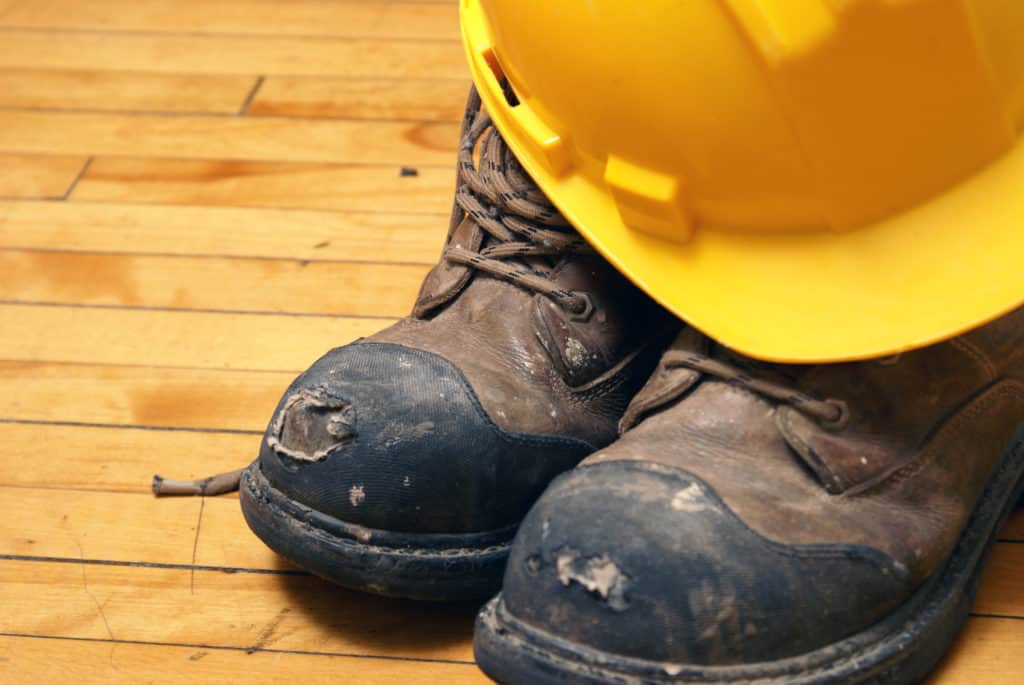The weather is starting to warm up here and that means a return to t-shirts and lightweight trousers, as opposed to thick puffy coats and waterproof trousers that are difficult to move in, let alone work in. The nicer weather definitely brings some much-needed relief and makes working as an electrician considerably easier.
However, one downside of the warm weather is how hot my feet get in steel-toe cap boots. After returning home today and peeling off my hot sweaty socks (lovely image I know!) I decided to do some research and find out if electricians have to wear steel toe cap boots and if there are any better alternatives to steel toe cap boots for electricians out there!

Electricians should wear steel toe cap boots or an alternative type of work boot that provides an equal amount of protection against hazards such as penetrating or crushing objects. Electricians should replace their steel toe cap boots when the toe leather rubs away and the metal becomes exposed.
As I discovered from my research there are no direct rules stipulating steel toe caps must be worn. As with everything health and safety-related the guidance is put out there with the standards of protection that are expected and it is up to individuals and their employers to ensure they are meeting the required standard.
Do Electricians Need Steel Toe Boots?
OSHA, the Occupational Safety and Health Administration, does not require electricians to wear steel-toe boots in their line of work. However, an electrician’s preference or an employer’s requirement may differ when comparing alternative versions of Electrical Hazardous (EH) approved boots.
According to OSHA, electricians must wear shoes that are non-conductive and protect against any open circuits or electrical hazards that are common and uncommon.
It is also vital for electrical workers to ensure their feet are safe and protected from non-electrical hazards, such as rolling equipment, penetrating or crushing objects, poisonous or biohazardous materials, and any hot or corrosive materials.
Since electricians can work in numerous environments and locations indoors, outdoors, above ground, and underground, there are more than electricity and electrical hazards to be aware of.
While electricians do not need steel-toe boots, standard protective footwear is required. Safety shoes must be worn at all times while on the job and consist of a leather upper, non-skid soles, oil-resistant, built-in toe caps, and have an impact and compression resistance of 75. OSHA-approved work shoes or boots must be certified by the ASTM to meet impact and compression resistance standards.
Composite toe boots are popular among electricians since they do not have metal plate-like steel toe boots but can still meet the minimum OSHA requirements for non-conductive protective footwear. Steel toe boots are generally covered to ensure that the metal is not exposed, making them non-conductive.
Keeping the metal covered protects electricians from electrocution risks while working with wires and open circuits. Still, it is crucial to examine the boots frequently for any rips or tears that could expose the metal pieces.
Also see: Do Electricians Buy Their Own Tools?
Why Do They Put Steel Toe Caps On Boots?
Steel toe caps are put on boots to promote an everyday boot to a safety boot. The caps are used to protect the wearer’s feet from hazardous conditions at the job site. Dangerous situations can include but not be limited to frequent rolling equipment like forklifts, carts, wagons, motorized vehicles, large barrels, etc.
Other hazardous conditions can be less evident as rolling equipment and come in the form of:
- nails
- screws
- wood shards
- glass
- knives
- scissors
- pots and pans
- any other penetrating, crushing, or falling objects that can cause severe pain and damage.
Chemicals, poisons, and corrosive, hot, and cold materials are also hazardous and require proper protection to stay safe.
Since the toes are an extension of the foot, they are the most vulnerable to injury and accidents and need extra care in certain situations and circumstances. Job sites that mandate steel toe shoes include warehouses, landscaping, construction, welding, machine operations, renovating and remodeling, auto repair, electricians, and manufacturing plants.
Job-specific duties may require an employee to wear steel toe-capped boots if potential danger is present. We’ll often see examples of this when an engineer visits a site and has to change from office shoes into safety boots before being allowed on site.
Steel toe caps are not the only caps used in safety protective footwear. Composite toe caps, aluminum, and thermoplastic polyurethane (TPU) are also used in protective shoes and boots. Steel toe caps are a heavier material than other options, but as technology has advanced, they have become less weighed down and easier to move around in.
Composite toe caps are metal-free and made from Kevlar, carbon fiber, and fiberglass materials. Aluminum and TPU caps are also lightweight and offer more protection than standard sneakers or everyday boots. Rubber caps can be adhered to the toe of the boots to protect the leather covering the outside of the plate from increased wear and thinning, ultimately extending the boot’s life.

Do electricians Have To Wear Boots?
Boots are necessary for electricians since they offer toe, foot, heel, and ankle protection and comfort. Toe caps, steel or composite, keep the toes safe from falling objects, rolling equipment, and corrosive material. Safety trainers are an alternative but are often banned on sites due to a lack of ankle protection.
The non-slip soles are designed to keep the wearer on their feet rather than slipping on water, oil, grease, chemicals, or other liquids found at the worksite. Rubber outsoles help with traction and not falling, keep liquids out of the shoe, and act as a grounding material from electric shocks.
The higher back of a work boot gives essential ankle protection with every step, going up and down ladders, or working on uneven terrains. Leather uppers can be waterproofed to keep feet dry all the way around and add an extra layer of security.
Remaining comfortable throughout the workday is a high priority. Based on the variety of conditions an electrician will be required to work in, shoes that can protect from external injury, internal injury, and prevent tired feet are going to be essential to getting work done correctly and efficiently. If an electrician’s attention is more focused on painful feet, the potential for mistakes and electrical hazards rises.
Also See: 15 Cool Gift Ideas For Electricians
Is Wearing Steel Toe Boots Every Day Bad For Your Feet?
Wearing steel toe boots every day is not bad for your feet. However, if the shoes do not fit comfortably, are too tight, or are too loose, they can cause problems and irritation. Since electricians can work a standard forty-hour workweek and still get called for service calls and emergencies outside of those hours, it is crucial to find a pair of steel or composite toe boots that fit well with insoles and socks.
Foot problems from steel-toed boots are blisters, calluses, corns, hammertoes, crossover toes, plantar fasciitis, bunions, ankle sprains, and metatarsalgia. Most, if not all of these, can be prevented. Ensure you have the correct boot size with the right socks and pay attention to how your feet feel.
Make sure your toes fit well within the toe box and do not rub or touch the steel cap or feel tight along the outer walls of the shoe. The boot’s weight is something the body will gradually become adjusted to. Inserts and insoles are beneficial to add a layer of cushioning for extended wear and protect against calluses, corns, and bunions.
It is also essential to take a break from standing, walking, and climbing to allow your feet to rest throughout the day. I always find changing into a pair of old trainers for the drive home provides some much-needed foot relief after a long day!
Alternatives To Steel Toe Boots For Electricians?
Composite toe boots are popular among electricians who do not want to wear steel toe shoes. Five of the most protective composite toe boots for electricians are the Carhartt Men’s CMF6366, Thorogood Men’s Composite Safety Toe Gen Flex 804-4445, Timberland PRO TiTAN, Ariat Men’s Overdrive XTR Pull-on H20, and the Wolverine Men’s Tarmac. Each of these brands provides excellent protection, proven durability, and superior comfort.
Composite toe boots are lightweight, slip-resistant, shock-absorbing, and can be made to be waterproof, have rubber outsoles, and fatigue-fighting designs.
Aluminium and TPU toe cap boots are also sold that are more lightweight than steel-toed boots while providing the same amount of protection and comfort. Rubber boots with non-slip soles and ankle support are excellent boots for electricians responding to calls in flooded areas or locations prone to rainfall and wet environments.
Are Steel Toe Boots Illegal In Public?
It is not illegal to wear steel-toe boots in public. However, some businesses and locations do not allow steel toe boots to be worn due to the risks of violent outbreaks and boots being used as weapons. Nightclubs and specific concert venues are among the list of places steel toe boots are likely to be banned and forbidden.
Most tradesmen know that after a long day in steel toe boots the thought of wearing them out in public is far from appealing anyway! Although, it is worth remembering after a long day if you decide to stop at a bar for a drink on the way home you may be denied entry.
Conclusion
I started this article by looking at the question, should electricians wear steel-toe boots? in a hunt to find a more comfortable and lightweight alternative. What I have discovered and what I am definitely going to give a try when my current pair of boots wear out, is composite toe boots.
Composite toe boots seem to meet all the safety requirements (for the places I work at least) but seem to be a lighter and more breathable alternative. Once I have bought some and given them a whirl, ill let you know how I got on!

